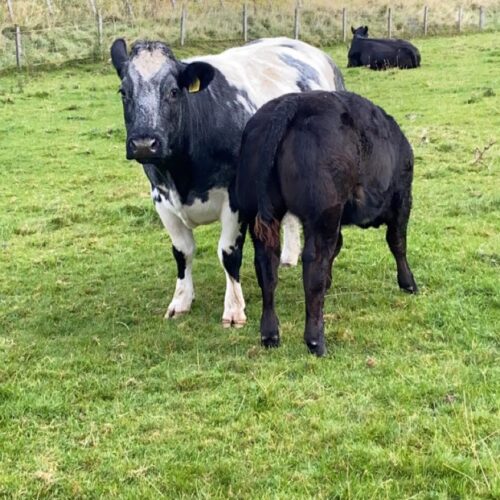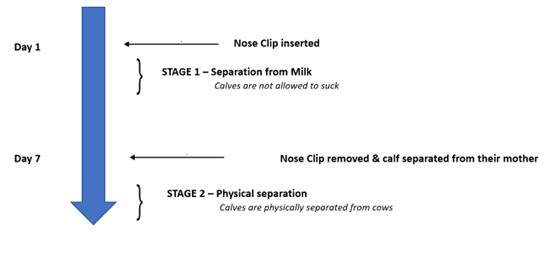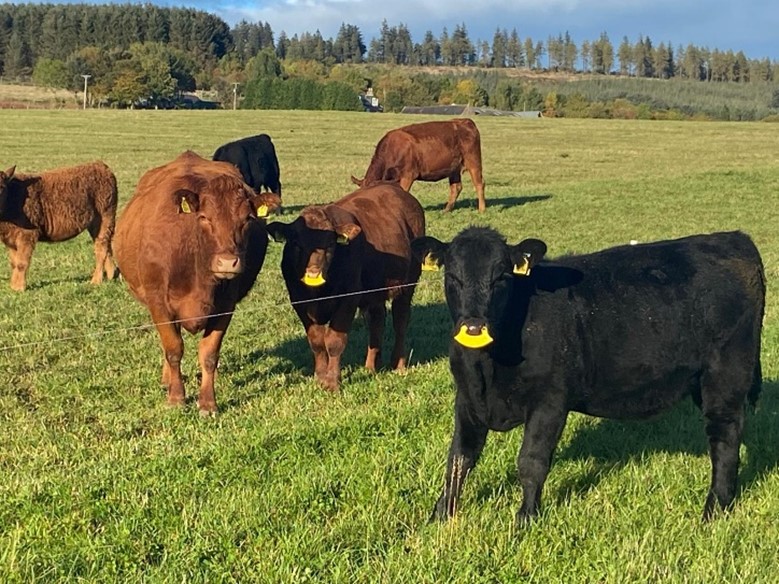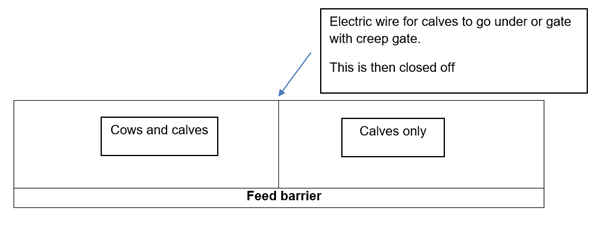Beef Toolkit – Weaning Beef Calves
7 September 2023Weaning of cows and calves is done so that the cow can recover body condition by transferring her nutrition from milk production to maintaining herself, allowing her to prepare for her next calf.
Weaning can be a stressful time, especially for the calves. However there are a number of steps farmers can take to help reduce the stress of weaning and the associated growth checks that weaning stress can cause. These include:
- Avoid housing and weaning at the same time, allowing for only one change at a time.
- If the calves are housed ensure the buildings have good ventilation.
- If the calves are being vaccinated for pneumonia, do this prior to housing.
- Allow for gradual changes to the diet e.g. introduce creep feed before weaning.

For more information on reducing weaning stress click: https://www.fas.scot/article/weaning-calves-reducing-the-stress/
When to Wean
The decision of when to wean calves, will differ from farm to farm and depend on a number of variables including:
- Cow condition score.
- Feed and forage availability.
- Calf performance.
Cow condition is key when considering when to wean, to allow the cow time to recover before rearing her next calf.
Lean Cows
For lean cows, weaning calves earlier is a good management tool. The weaning date can vary from year to year and should be decided depending on the forage availability, cow condition and the performance of the calves. Weaning earlier allows the cow to transfer her nutrition from milk production to her own body processes and gain condition before the next calf is born. Weaning age can vary from the calves being five months old, right up to 10 months old depending on the year. If a large proportion of the herd are too lean at weaning then enquiries should be made with a vet to investigate the cause.
Over Fat Cows
Delaying weaning is a good management tool for over fat cows, to ensure they are using some of their nutrition to produce milk, and not lay on more fat. Another management tool would be to put the cows on to tight grazing, by increasing the stocking density or offering poor grazing to attempt to slim them down, however this may be counterproductive as the calves will then also have restricted grazing, which can impact their performance. Carrying additional condition at housing can offer a benefit of the cow requiring less supplementary feeding throughout the winter period, which can reduce the winter cost of keeping a cow. Ideally cows should be body condition score 3 – 3.5 at housing, with this in mind condition score cows when weaning and manage them according to the result e.g. lean cows in a separate group from over fat cows, to allow for tailored nutrition.
The availability of feed and forage will influence when calves are weaned. In years where there are forage shortages, consider weaning earlier to relieve grazing pressure. Calf growth rates and weight gains will be reduced if there is insufficient or poor-quality grazing.
The performance of the calf is the final tool to look at when deciding when to wean. If calf performance is poor or not as expected it may be a health issue e.g. worms or it may be due to milk or forage availability. Monitor and evaluate calf performance, and if it is not as expected then investigate the cause.
Creep Feeding
Creep feeding calves before weaning is beneficial in aiding calves transition through weaning, by preparing the rumen for a change in diet composition from milk to forage.
Advantages of Creep feeding before weaning:
- Increased weaning weights.
- Reduced weaning check.
- Reduced risk of pneumonia.
When to start creep feeding will depend on the age of the calf, cow condition and grass availability. Ideally offering creep feed 6 – 10 weeks before weaning is most beneficial. In situations where it is difficult to creep feed, offering feed 4 – 6 weeks before weaning will still help with reducing growth check at weaning. If there are young bulls that are going to be on an intensive finishing system, then these would benefit from feeding creep 12 weeks before weaning.
For more information on creep feeding calves prior to weaning please see:
https://www.fas.scot/article/why-to-creep-feed-spring-born-suckled-calves/
https://www.fas.scot/article/when-to-start-creep-feeding-spring-born-suckled-calves/
Gradual changes
Weaning can be a stressful time for calves, as there are many changes within its life are occurring, including the maternal bond being broken and milk being removed from their diet. These changes should be done gradually to reduce the stress calves experience at any one time.
To reduce the amount of changes at one time, one step that can reduce stress includes avoiding housing and weaning at the same time. Weaning should ideally occur at least two weeks before housing and newly weaned calves should be offered good quality grass prior to housing, with them being brought inside after the initial stress of weaning has passed. Other management procedures that may occur at housing e.g. dehorning should be delayed to further reduce stress on the animals.
It is advisable if the farm practice is to vaccinate against pneumonia and clostridial diseases, that this is done before housing. Stress can affect the processes of the immune system, making calves more susceptible to disease. This would ensure that the stress at weaning is minimised, allowing the calves to continue to perform. For routine vaccinations it is important to check the data sheet and to speak to your vet about the optimal timing.
When weaned calves are being housed avoid mixing different groups and ages of calves. Calves from different groups may have been exposed to different bugs, therefore will have varying levels of immunity. Keeping calves in their social groups will reduce the risk of disease spread and help to reduce stress.
Ensure that calves are housed in well-ventilated, airy sheds, preferably housed dry as wet backs will raise the humidity and increase the risk of pneumonia.
Once calves are housed, continue to feed the same diet to that which was offered in the creep mix in the field then gradually transition onto store or finisher diets, ensuring that good quality forage and fresh clean water is always available.
Weaning Methods
There are several methods of weaning calves, depending on the farming system and facilities/infrastructure. The main aim at weaning is cause as little stress as possible, to both the cows, calves and humans. There are different forms of two-stage weaning strategies, which offer lower stress and allow gradual weaning. Different methods include:
- Anti sucking devices.
- Forward creep grazing.
Using anti sucking devices
An anti-sucking device, consists of a nose flap that is attached to the calf’s nostrils. The calf is weaned from milk by the nose flap preventing the calf from sucking its mother, but with the benefit that it remains having social contact with its mother through this nutritional change. When the calf stops trying to suck its mother (around 7 days later), it is weaned from its mother, the nose flap or anti-sucking device is removed and the calf is separated from its mother. This allows the stress of diet transition and loss of social interaction with its mother to be staged and not two changes occurring at the same time.
An example of the timeline for using the nose clips is shown below,

The disadvantage to this system is that the calves need to be handled twice throughout the weaning process, to put on and take off nose clips which adds to workload, labour requirements and could also be stressful for the calves.
For more information on one farmer’s experience of the use of nose flaps the following video may be of interest;
https://www.fas.scot/publication/grazing-vlogs-weaning-management-at-scholland-farm/

Photo Credit: Duncan Morrison
Forward creep grazing or in-shed creep areas
An alternative method of weaning is to allow calves to go through a creep gate or under some high electric fence posts if fields are sectioned for a period of a week or more. The gates are then closed off, with the cows and calves separated, however they are in fields next to each other. This method works in both a field and shed situation.
In sheds calves can be allowed access to a separate section away from their mothers. They would start to flow through to this creep area at their own choice before being shut through for longer periods of time, before access is completely shut off and the calves are weaned. An illustration is shown below of how this may work in a shed.

Weaning Top Tips
- Introduce creepa minimum of four weeks before housing.
- Avoid housing and weaningcalves at the same time to minimise stress.
- Do not dehorn or castratea month before or after weaning to minimise stress.
- Vaccinateagainst pneumonia before housing.
- Housein well-ventilated sheds.
- Do not mix groups of calves because of the risk of disease.
- Introduce store or finisher diets gradually, alongside good quality forage initially. Slowly transition from the creep feed diet.
- Asses low stress weaning methods.
Written by: Sarah Balfour, SAC Consulting
Sign up to the FAS newsletter
Receive updates on news, events and publications from Scotland’s Farm Advisory Service

